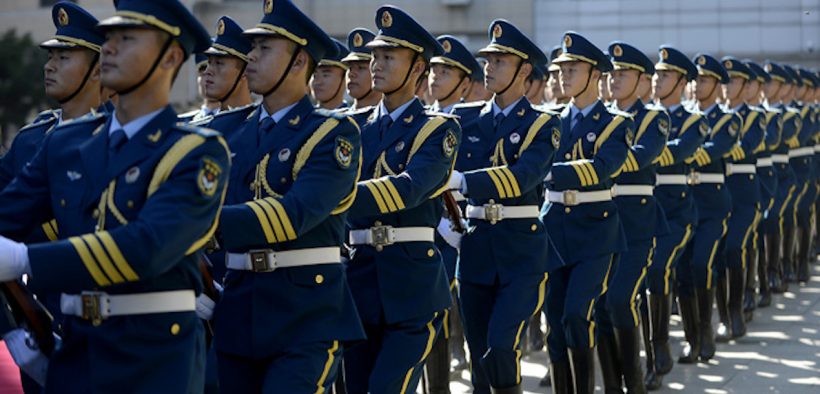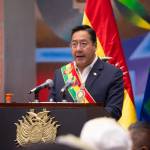Five Key Points From China’s New Defense White Paper

“If anyone dares to separate Taiwan from China, the Chinese army will certainly fight, resolutely defending the country’s sovereign unity and territorial integrity.”
On Wednesday, July 24, China released its white paper on defense titled “China’s National Defense in The New Era,” which largely highlighted the country’s surge in military spending and blamed the U.S. for causing world chaos.
“The world is not yet a tranquil place. The international security system and order are undermined by growing hegemonism, power politics, unilateralism, and constant regional conflicts and wars,” said the document.
The paper’s release came amid an air confrontation involving warplanes from China, Russia, Japan and South Korea in East Asian waters. Russia claimed it was carrying out a joint air patrol with China following an accusation from Seoul that Moscow had violated South Korea’s airspace.
Below are five takeaways from the paper, the first such paper since 2015 when President Xi Jinping called for a massive military overhaul.
The US Is to Blame for the World’s Instability
Beijing slammed Washington for ruining global stability, adding that the U.S. has triggered competition among countries.
“The U.S. has adjusted its national security and defense strategies and adopted unilateral policies. It has provoked and intensified competition among countries, significantly increased its defense expenditure … and undermined global strategic stability,” the document said.
The 52-page paper cited the placement of the Terminal High Altitude Area Defense (THAAD) system in South Korea as a threat to regional security. China also referenced the efforts of U.S. “allies” such as Japan and Australia to build up their military.
“Japan has adjusted its military and security policies and increased input accordingly, thus becoming more outward-looking in its military endeavors,” while “Australia continues to strengthen its military alliance with the U.S. and its military engagement in the Asia-Pacific, seeking a bigger role in security affairs.”
Beijing Vows to Take Taiwan
According to the paper, one of China’s main priorities is to integrate Taiwan and wage war against what it calls separatists in Tibet and the northwest province of Xinjiang.
“The ‘Taiwan independence’ separatist forces and their actions remain the gravest immediate threat to peace and stability in the Taiwan Strait and the biggest barrier hindering the peaceful reunification of the country,” said the paper.
China has refused to rule out the use of military force to re-unify Taiwan, vowing to take any military measures needed to combat the separatists.
China’s Defense Ministry spokesman Wu Qian warned against a growing threat from Taiwan’s pro-independence activists, adding that whoever seeks Taiwan’s independence from China will have their wishes ruined.
“If anyone dares to separate Taiwan from China, the Chinese army will certainly fight, resolutely defending the country’s sovereign unity and territorial integrity,” Wu said, as Business Insider reported.
The paper also blamed Taiwanese President Tsai-ing Wen for using foreign influence to attack the mainland and also escalating tensions.
Taiwan, a democratically-governed island, split from China ruled under the Communist Party amid the civil war in 1949. China still considers Taiwan a part of the mainland and never recognized it as an independent state and instead adopted a doctrine called the “One China Policy.”
Tensions between Washington and Beijing have intensified after the latter threatened to punish three American companies that sell arms to Taiwan. China’s Foreign Ministry saw the arms sales as a violation of international law.
China Seeks Military Cooperation With Russia, Not an Alliance
On Tuesday, July 24, a rare face-off involving fighter jets from Russia, China, South Korea and Japan struck near a small, disputed island off the coast of South Korea and Japan. Japan and South Korea accused China and Russia of violating their airspace.
China claimed its bombers were taking part in a joint air patrol with Russia and argued it complied with international law. According to CNN, Russia claimed that South Korean military jets “had dangerously intercepted two of its bombers during a planned flight over neutral waters.” South Korea fired over 300 warning shots in response.
The Chinese defense paper stated the importance of Sino-Russia military cooperation saying that “the military relationship between China and Russia continues to develop at a high level, enriching the China-Russia comprehensive strategic partnership of coordination for a new era and playing a significant role in maintaining global strategic stability.”
Some experts saw what happened on Tuesday morning near the barren tiny island that both Japan and South Korea lay claim to as a warning sign to Washington, Seoul and Tokyo – a warning that Russia-China military cooperation has entered a new level and is aimed at expanding their influence in the Asian Pacific.
“The most significant strategic aspect of this incident is it highlights a new and higher level of Sino-Russian military cooperation,” Carl Schuster, a former U.S. Navy captain and former director of operations at the U.S. Pacific Command’s Joint Intelligence Center, told CNN.
However, China only wants a partnership, as Wu said, not an alliance, meaning there is no desire for a formal pact committing both China and Russia to protecting one another in case of war.
Russia and China still see each other as a threat, given that they share the same ambition to be the global military powerhouses.
China Has Nuclear Weapons For Self-Defense
China’s white paper emphasized its pursuit of a nuclear strategy purely for self-defense, aimed at preventing other countries from threatening Beijing with their nuclear arms.
Beijing also claimed it supported a total ban on nuclear weapons and it keeps its nuclear arsenal at a minimum level needed for national defense.
“China is always committed to a nuclear policy of no first use of nuclear weapons at any time and under any circumstances, and not using or threatening to use nuclear weapons against non-nuclear-weapon states or nuclear-weapon-free zones unconditionally. China advocates the ultimate complete prohibition and thorough destruction of nuclear weapons. China does not engage in any nuclear arms race with any other country and keeps its nuclear capabilities at the minimum level required for national security,” said the paper.
According to the latest figures from SIPRI, the U.S. and Russia control around 90 percent of the world’s total nuclear warheads (over 6,000 each), whereas, China is estimated to have 280 warheads in total.
A Surge in Military Spending
China continues to modernize its military equipment by increasing its military expenditure. From 2012 to 2017, Beijing hiked its military spending by 1,459 percent.
“From 2012 to 2017, China’s defense spending increased from 669.192 billion yuan to 10,432.37 billion yuan. China’s GDP grew at an average annual rate of 9.04 percent at the current year’s price, the national fiscal expenditure grew at an average annual rate of 10.43 percent, the national defense expenditure grew at an average annual rate of 9.42 percent, and the national defense expenditure accounted for an average of 1.28 percent of GDP,” the white paper revealed.
Stockholm International Peace Research Institute (SIPRI) data showed that China was the second-largest military spending country in 2018 after the U.S. (followed by Saudi Arabia, India and France). In 2018, China raised its military spending for the 24th consecutive year by 5 percent.
Despite China’s efforts to improve its military force, Beijing admitted it is still far behind military superpowers like the U.S. and Russia.
Yan Guang, a former colonel in China’s armed forces, said the diminutive comparison to the Russian and the U.S.’ military was meant to snub allegations of China as a threat, adding that Beijing’s defense expenditure is still at a normal level.
“We can see that the military expenditure was allocated evenly among the three areas of personnel, training and equipment. And the overall growth has been stable with no dramatic increases or decreases. This is meant to show that it [the PLA] has taken a defensive, stable and rational approach,” he said, as the Korea Herald reported.




















“The world is not yet a tranquil place.” There’s a news flash for you. Does “yet” imply that the world is somehow going to become “a tranquil place”? The War to End All Wars was which one? Reading world history — including yesterday’s — does not inspire optimism.